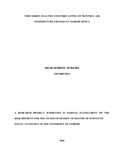| dc.description.abstract | Climate change has for a long time been the biggest debate among many people all over the
world. Temperature is a key element that can be used to detect climate change. Time series
analysis and forecasting is one of the major tools used by scientists in meteorological and
environmental fields to study phenomena like temperature, rainfall and humidity. The aim of this
research is to build a time series SARIMA model and use this model to analyze and forecast the
maximum and minimum air temperature of Nairobi City in order to inform stakeholders who
depend directly or indirectly on it to plan in advance. The appropriate orders of models are
picked based on the results of ACF and PACF plots and evaluated using the AIC criterion. The
best forecasting SARIMA model for maximum temperature is (0, 0, 2) (0, 1, 1)12 and that for
minimum temperature is (1, 0, 0) (0, 1, 1)12. The results show that the minimum temperature is
gradually increasing over years supporting the fact that global warming is real. | en_US |



